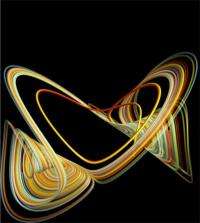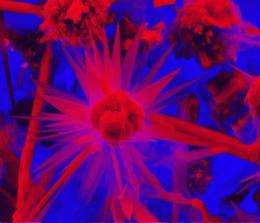'Intelligent design' theme of Art of Science exhibit

Research images from Princeton University's fifth "Art of Science" competition – whose theme is "intelligent design" -- are now available for viewing in an online gallery: http://www.princeton.edu/artofscience/gallery2011/
"In recent years, the phrase 'intelligent design' has taken on a polarizing meaning," said Art of Science co-organizer Andrew Zwicker, who is the head of Science Education at the Princeton Plasma Physics Laboratory (PPPL) and a lecturer in the Princeton Writing Program. "But in the broadest sense, beautiful objects, both natural and the manufactured, have an intelligence to their form, their function, and thus, their design."
Art of Science co-organizer Adam Finkelstein, professor of computer science at Princeton and a co-organizer of the competition, said that the theme for the 2011 exhibit came from a desire to reframe the phrase "intelligent design."
"We wanted to celebrate the idea that both nature and the rearranging of the natural world have inherent beauty," Finkelstein said.
Zwicker said that the term "intelligent design" encompassed a wide range of potential images: a field rabbit regulating its body temperature through its posture; a simulation of the birth of a galaxy; an electron micrograph of a computer chip created with novel materials.

"We sought images that captured the exquisite harmony of such systems," Zwicker said.
First Prize for the competition went to Christophe Gissinger, a postdoctoral researcher in Astrophysics and with the Princeton Plasma Physics Laboratory for his "Chaos and geomagnetic reversals." Second Prize went to Zhen James Xiang, a graduate student in Electrical Engineering for "Tree." Third prize went to Xuening Bai, a graduate student in Astrophysics, and James M. Stone, a professor in Astrophysics, for their "Dust to Dust, to Planets?"
Cash prizes were given to the top three winners: $250 for first place, $154.51 for second; and $95.49 for third. These amounts are derived according to the golden ratio, a mathematical proportion that has been found in aesthetically pleasing designs, from seashells to ancient Greek temples.
Pablo Debenedetti, Class of 1950 Professor in Engineering and Applied Science and Vice Dean of Princeton's School of Engineering and Applied Science, called Art of Science a "one-of-a-kind event."
"Scientists seek to understand how the universe works and engineers design and make objects that improve people's lives," he said. "Although both activities are beautiful, they do not in general pursue visual beauty as a major goal. But sometimes, while doing science or engineering, art happens, and objects are created that possess true aesthetic beauty."
Debenedetti announced the winners of the competition at an opening reception of the physical gallery on November 11 in the Friend Center on the Princeton campus. That gallery is free and open to the public and viewable from 9 a.m. to 5 p.m. Monday through Friday. The exhibit will remain on display through May of 2012 at which time the Princeton Art of Science organizers plan to launch a multi-institutional Art of Science exhibit both at a New York gallery and online.
The organizers solicited images made in the course of scientific research that have aesthetic value rather than art that is inspired by science.
Jurors for the competition were President Shirley M. Tilghman; Dean of the Faculty David Dobkin, Phillip Y. Goldman '86 Professor in Computer Science; and Joel Smith, Peter C. Bunnell Curator of Photography, Princeton University Art Museum.
Sponsors of the competition are David A. Gardner '69 Fund in the Humanities Council, the School of Engineering and Applied Science, PPPL, PICSciE, the Lewis Center for the Arts, and the Office of the Dean for Research.
In addition to Finkelstein and Zwicker, the 2011 Art of Science organizers included Zach Donnell, a graduate student in molecular biology; Christina Gupfinger, a senior majoring in ecology and evolutionary biology; and Teresa Riordan, senior new media editor of the School of Engineering and Applied Science.
Provided by Princeton University, Engineering School

















